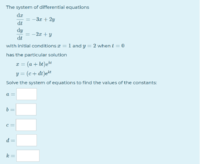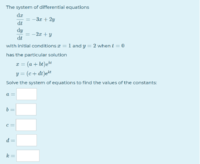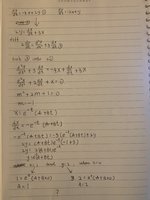I don't know why i got same x and y.
- Thread starter Traccccy
- Start date
Steven G
Elite Member
- Joined
- Dec 30, 2014
- Messages
- 14,593
You wrote that you are substituting (equation 3) into 2*(equation 1)
The next line does not seem to reflect that. If I am wrong you must have skip some steps, which is fine by me. If you think you are correct and since I do not see these missing steps can you supply them to me.
The next line does not seem to reflect that. If I am wrong you must have skip some steps, which is fine by me. If you think you are correct and since I do not see these missing steps can you supply them to me.
HallsofIvy
Elite Member
- Joined
- Jan 27, 2012
- Messages
- 7,763
dtdx=−3x+2y
dtdy=−2x+y
Differentiate the first equation again
dt2d2x=−3dtdx+2dtdy
Replace dtdy in that using the second equation
dt2d2x=−3dtdx+2(−2x+y)=−3dtdx−4x+2y
From the first equation, 2y=dtdx+3x
Replacing 2y in the last equation by that
dt2d2x=−3dtdx−4x+dtdx+3x
dt2d2x=−2dydx−x
dt2d2x+2dtdx+x=0
That "second order linear equation with constant coefficients" in the single variable, x, has characteristic equation r2+2r+1=(r+1)2=0 so has a double characteristic root -1. Two independent solutions are e−t and te−t.
The general solution, for x, is x(t)=Ae−t+Bte−t where A and B are undetermined constants.
To find y, use
2y=dtdx+3x=−Ae−t+Be−t−Bte−t+3Ae−t+3Bte−t=2Ae−t+4Be−t+2Bte−t
so
y(t)=(A+2B)e−t+Bte−t
dtdy=−2x+y
Differentiate the first equation again
dt2d2x=−3dtdx+2dtdy
Replace dtdy in that using the second equation
dt2d2x=−3dtdx+2(−2x+y)=−3dtdx−4x+2y
From the first equation, 2y=dtdx+3x
Replacing 2y in the last equation by that
dt2d2x=−3dtdx−4x+dtdx+3x
dt2d2x=−2dydx−x
dt2d2x+2dtdx+x=0
That "second order linear equation with constant coefficients" in the single variable, x, has characteristic equation r2+2r+1=(r+1)2=0 so has a double characteristic root -1. Two independent solutions are e−t and te−t.
The general solution, for x, is x(t)=Ae−t+Bte−t where A and B are undetermined constants.
To find y, use
2y=dtdx+3x=−Ae−t+Be−t−Bte−t+3Ae−t+3Bte−t=2Ae−t+4Be−t+2Bte−t
so
y(t)=(A+2B)e−t+Bte−t



